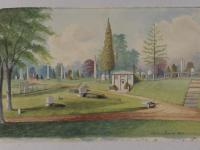As a researcher for the Research by Mail service at HSP, I recently worked with a patron to locate the current burial location of his grandmother. The family knew the plot had been moved from its original Philadelphia cemetery due to redevelopment of the city block decades ago, but they were unsure where the new grave site was located.
Unfortunately, this is not unusual in Philadelphia, where multiple cemeteries have been relocated over the years as the city grew and changed. And information on new burial locations may not always be so obvious. Luckily at HSP, we have a variety of cemetery records within our collections, from cemetery histories to microfilm of scanned plot records and more.
In this particular case, it was a hunch that solved the case. Though I reviewed each internment record in the original cemetery’s records, the plot owner’s card was missing. At that point, I was able to determine only who was buried in the plot, which was a great discovery, but not the new burial location. A simple handwritten word, “hillside” on a few unrelated internment cards led to the answer.
We already knew the burial plot was not in the cemetery where other internments were transferred. As it turned out, “hillside” was not a description of the landscape, but another local cemetery. After calling and receiving verification that the plot had indeed been transferred to Hillside Cemetery, the HSP patron, who feared his grandmother’s grave had been forever lost, was finally able to take his mother to a tangible place to pay their last respects after many years. And through these interment records, they also learned more details about the grandmother’s extended family and that she was buried in a plot owned by her father.
In my personal experience, most of my research is far removed from living relatives, resulting in exciting discoveries but not necessarily a heart-tugging moment. This turned out to be one of those rare cases where both experiences collided.
If you are currently working on your own genealogy, I urge you to include the examination of both cemetery and death records. They are often untapped resources that can open the door to naming those unknown relatives, learning their place of residence, religious affiliations, cause of death or simply interesting details; such details as the "type of carriage used to escort the family to the service."
Visit our online catalog to start your own checklist of resources to assist your research prior to your next visit to HSP. Suggested initial search terms may include “cemetery”, “tombstone inscription” or the church/denomination of your interest. If you are unable to personally search our collection onsite, we would be glad to assist you through our Research by Mail service.

